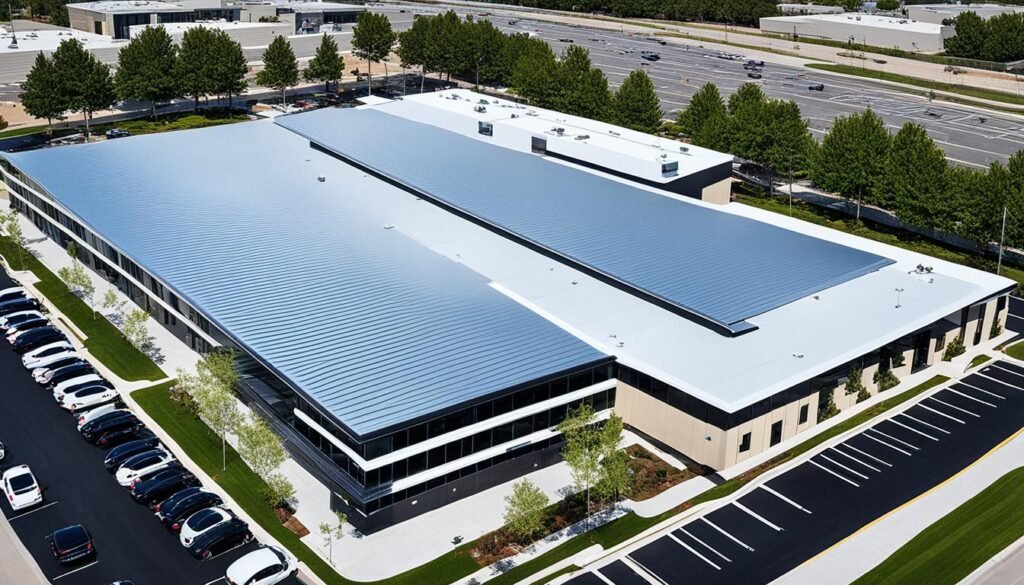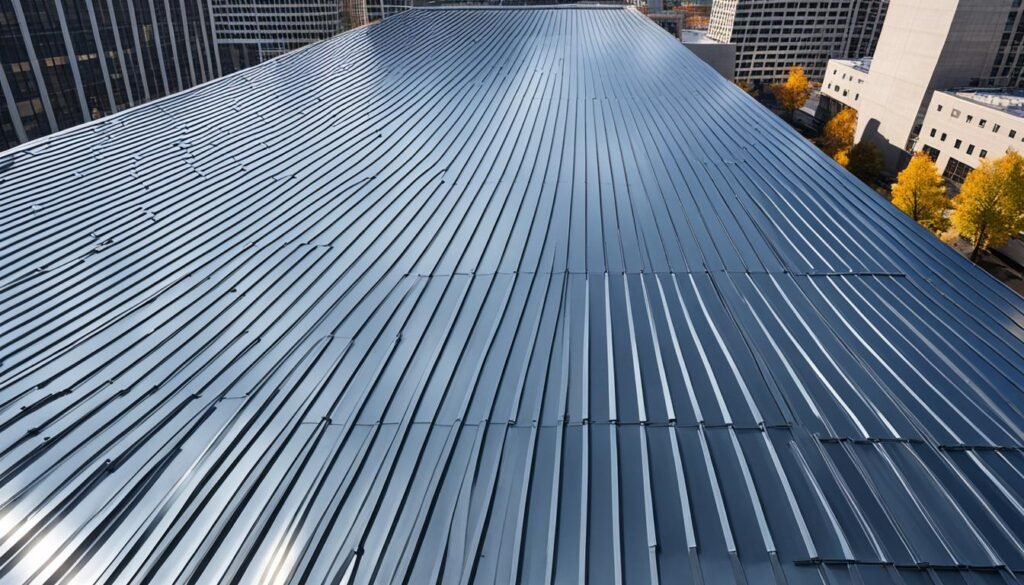Did you know that the type of roof you choose for your commercial building can significantly impact your expenses? In fact, certain roofing materials can be quite expensive, impacting your budget and long-term maintenance costs. It’s essential to consider the factors that determine the cost of a roof, such as durability, lifespan, and energy efficiency, to make an informed decision for your commercial property.
- Choosing the right roofing system for a commercial building is crucial for long-term budget planning.
- Different roofing materials have varying costs, durability, and energy efficiency characteristics.
- Consider factors like climate and building needs when selecting a roof type.
- Some expensive roof options include single-ply roofing, metal roofs, and built-up roofing systems.
- Consulting with a professional roofing contractor can help you make an informed decision.
Single Ply Roofing
When it comes to selecting the right roofing system for your commercial building, single ply roofing offers a compelling solution. Although it falls under the category of expensive roofing materials, the benefits it provides make it a high-cost roofing option worth considering.
Single ply roofing systems utilize materials like TPO (Thermoplastic Olefin), PVC (Polyvinyl Chloride), and EPDM (Ethylene Propylene Diene Monomer). These materials are known for their exceptional flexibility and resistance to weathering, ensuring that your roof can withstand the test of time.
One of the key advantages of single ply roofing is its ease of installation. These systems are specifically designed to be installed in a single layer, which not only saves installation time but also reduces costs. This efficiency can be particularly beneficial for large commercial buildings where time and budget constraints are important considerations.
While single ply roofing systems may come with a higher upfront cost compared to other options, they offer durability and low maintenance requirements. This combination makes them a wise long-term investment for commercial property owners. By choosing a high-quality single ply roofing system, you can minimize the need for frequent repairs and replacements, resulting in cost savings over time.
Furthermore, single ply roofing systems provide added benefits such as energy efficiency and environmental friendliness. These roofs often have reflective properties that help reduce heat absorption, ultimately lowering energy consumption and costs. Additionally, they are recyclable, contributing to sustainable construction practices.
In summary, single ply roofing systems offer a robust and reliable option for commercial buildings. Although they may be categorized as expensive roofing materials and high-cost roofing options, their durability, low maintenance, and energy efficiency characteristics make them a worthwhile investment. Consult with a professional roofing contractor to determine the best single ply roofing system for your specific needs.

Advantages of Single Ply Roofing Systems:
- Exceptional flexibility and resistance to weathering
- Efficient installation in a single layer, reducing time and costs
- Durability and low maintenance requirements
- Energy efficiency and sustainability
| Advantages | Disadvantages |
|---|---|
| Exceptional flexibility and resistance to weathering | Higher upfront cost |
| Efficient installation, reducing time and costs | Additional insulation may be required |
| Durability and low maintenance requirements | Installation complexity may vary depending on the material |
| Energy efficiency and sustainability |
Metal Roofs
Metal roofs are considered one of the top expensive roof styles due to their durability, longevity, and luxurious aesthetic appeal. These roof types can last up to 50 years or more with proper maintenance, making them a long-term investment for commercial buildings.
Although metal roofs may have a higher upfront cost compared to other roofing materials, they offer exceptional resistance to fire, impact, and extreme weather conditions. This durability ensures that your commercial building will remain protected for years to come.
Additionally, metal roofs provide energy efficiency benefits, reflecting sunlight and reducing heat absorption. This can lead to lower energy costs over time.
Not only do metal roofs offer practical advantages, but they also enhance the overall value of a commercial property. Their sleek and modern design can significantly improve the curb appeal and attractiveness of the building.

Metal roofs are known for their exceptional durability, resistance, and longevity. Installing a metal roof can be a significant investment, but the long-term benefits and luxurious appearance make it worth considering for your commercial building.
Advantages of Metal Roofs
- Long lifespan of up to 50 years or more
- Superior resistance to fire, impact, and extreme weather conditions
- Energy efficiency benefits, reducing heating and cooling costs
- Enhanced curb appeal and overall value of the commercial building
Disadvantages of Metal Roofs
- Higher upfront cost compared to other roofing materials
- Potential noise during rain or hailstorms without proper insulation
- May require professional installation due to the complexity of the material
- Requires regular maintenance to prevent corrosion or rust
| Advantages of Metal Roofs | Disadvantages of Metal Roofs |
|---|---|
| Long lifespan of up to 50 years or more | Higher upfront cost compared to other roofing materials |
| Superior resistance to fire, impact, and extreme weather conditions | Potential noise during rain or hailstorms without proper insulation |
| Energy efficiency benefits, reducing heating and cooling costs | May require professional installation due to the complexity of the material |
| Enhanced curb appeal and overall value of the commercial building | Requires regular maintenance to prevent corrosion or rust |
Green Roofs
When it comes to pricey roofing solutions, green roofs are an excellent choice for commercial buildings. These premium roofing materials not only offer a visually appealing aesthetic but also provide numerous benefits in terms of sustainability and environmental impact.
Green roofs consist of layers of waterproofing, drainage, and vegetation, creating a natural insulation system that helps regulate temperature and reduce energy costs. The vegetation absorbs sunlight and heat, reducing the need for mechanical cooling systems. This energy-efficient feature contributes to long-term cost savings and environmental preservation.
Furthermore, green roofs improve air quality by filtering pollutants and carbon dioxide, enhancing the overall health and well-being of building occupants. The vegetation acts as a natural air purifier, reducing the impact of urban air pollution.
Additionally, green roofs are effective in managing stormwater runoff, which is a common concern in urban areas. The waterproofing layers prevent rainwater from immediately entering the drainage system, reducing the risk of flooding and alleviating strain on local water infrastructure.
As with any premium roofing material, green roofs require ongoing maintenance and careful installation to ensure their longevity and performance. Professional expertise is crucial in implementing proper drainage systems, choosing suitable vegetation, and managing plant care. However, the long-term benefits and positive environmental impact make green roofs a worthwhile investment for commercial building owners.
Benefits of Green Roofs:
- Energy cost savings through natural insulation
- Improved air quality by filtering pollutants
- Effective stormwater management
- Enhanced aesthetic appeal
- Positive environmental impact
Comparison of Roofing Solutions
| Roofing Material | Durability | Installation Cost | Energy Efficiency | Maintenance Requirements |
|---|---|---|---|---|
| Single-Ply Roofing | High | Medium | High | Low |
| Metal Roofs | Very High | High | High | Low |
| Green Roofs | Medium | High | High | Medium |
| Built-Up Roofing Systems | High | Medium | Medium | High |
Built-Up Roofing Systems
Built-up roofing systems, also known as BUR, are well-regarded for their strength and durability, making them an excellent choice for commercial buildings with high foot traffic or exposed to extreme weather conditions. These costly roof designs consist of multiple layers of asphalt and felt that work together to create a robust and long-lasting roofing system.
The multi-layered construction of BUR roofs provides exceptional protection against harsh weather elements such as rain, wind, and UV rays. They are designed to withstand the test of time and can have a lifespan of up to 30 years or more with proper installation and regular maintenance. If you’re looking for a roofing solution that offers longevity and resilience, built-up roofing systems are worth considering.
However, it’s essential to note that BUR roofs may require additional support systems due to their heavyweight. The additional support ensures the structural integrity of the building. Additionally, as built-up roofing systems age, it can become more challenging to identify and fix leaks, necessitating the expertise of professional roofers for maintenance and repairs.
Despite the potential challenges, the durability and long lifespan of built-up roofing systems make them a valuable investment for commercial properties. With the right installation and maintenance, these costly roof designs can provide reliable protection and peace of mind for years to come.
For a closer look at the benefits of built-up roofing systems, refer to the table below:
| Advantages of Built-Up Roofing Systems | Disadvantages of Built-Up Roofing Systems |
|---|---|
| High durability and strength | Additional support systems may be required |
| Long lifespan | Challenging to identify and fix leaks as they age |
| Excellent weather resistance | |
| Exceptional protection against UV rays |
As shown in the table, built-up roofing systems offer significant advantages such as high durability, long lifespan, and excellent weather resistance. It’s important to weigh these benefits against the potential drawbacks, like the need for additional support systems and the challenges of leak detection.
In summary, built-up roofing systems are costly roof designs that provide exceptional strength and durability for commercial buildings. While they may require additional support systems and maintenance expertise, their longevity and weather resistance make them a worthwhile investment for property owners looking for a reliable roofing solution.
Conclusion
When it comes to choosing the best roof for your commercial building, several factors need to be considered. Durability, lifespan, energy efficiency, and budget are among the key considerations that can guide your decision. Throughout this article, we have explored various options, including single-ply roofing, metal roofs, green roofs, and built-up roofing systems, highlighting their advantages and disadvantages.
Each roofing material offers unique benefits. Single-ply roofing systems, such as TPO, PVC, and EPDM, provide flexibility and resistance to weathering, making them a durable and low-maintenance choice. Meanwhile, metal roofs offer longevity, enhanced visual appeal, and excellent protection against fire, impact, and harsh weather conditions.
For those seeking sustainable and eco-friendly solutions, green roofs present an attractive option. With their multiple layers of waterproofing, drainage, and vegetation, green roofs offer energy cost savings, improved air quality, and efficient stormwater management. On the other hand, built-up roofing systems, composed of layers of asphalt and felt, offer strength and durability, making them suitable for commercial buildings with high foot traffic or exposure to extreme weather.
Ultimately, the choice of the right roofing system for your commercial building will depend on your specific needs, local climate, and long-term objectives. To make an informed decision, it is recommended to consult with a professional roofing contractor. They can assess your requirements and guide you in selecting and installing the premium roofing materials and costly roof designs that align with your budget and ensure optimal performance and longevity over time.
FAQ
What are the options for the best roof for a commercial building?
The options for the best roof for a commercial building include single-ply roofing, metal roofs, green roofs, and built-up roofing systems.
What are the advantages of single-ply roofing?
Single-ply roofing, such as TPO, PVC, and EPDM, offers high flexibility, weather resistance, durability, and low maintenance.
Why are metal roofs considered a luxury roof type?
Metal roofs are known for their durability, longevity, aesthetic appeal, fire resistance, impact resistance, and weather resistance.
What are the benefits of green roofs?
Green roofs provide eco-friendly insulation, reduce energy costs, improve air quality, and manage stormwater runoff.
Are built-up roofing systems expensive?
Built-up roofing systems offer strength and durability, but they may require additional support systems and are more challenging to repair as they age.
How do I choose the best roof for a commercial building?
When selecting a commercial roof, consider factors such as durability, lifespan, energy efficiency, and budget. Consulting with a professional roofing contractor can help make an informed decision.